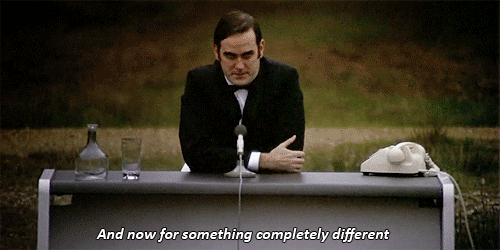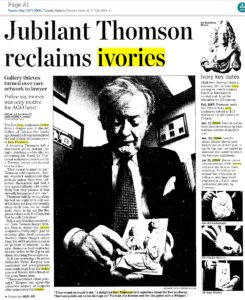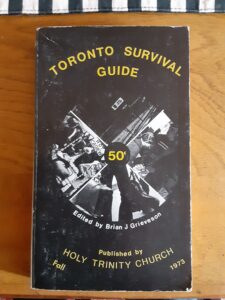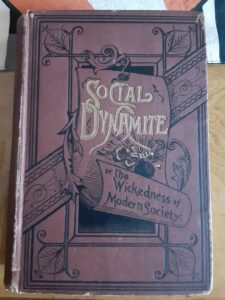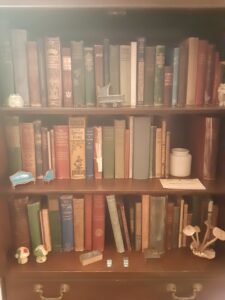Full Beaver Moon Eclipse (and a few more thoughts on the education workers’ strike and on social media and the public sphere more generally *deep inhale*)
 I awake as early as ever, and lie abed, cozy under the covers until remembering that the Beaver Moon is to be in full eclipse in the hour before dawn.
I awake as early as ever, and lie abed, cozy under the covers until remembering that the Beaver Moon is to be in full eclipse in the hour before dawn.
And there it is, hanging low above the western horizon, not long before setting: the Blood Moon.
I have not yet set up my new phone, and this one takes blurry shots in low light, but I go outside to capture what I can of it anyway. The moon: not cheese; not a man; not inhabited by a fox; not chased by wolves—just beautiful Selene, or perhaps just a trace of her chariot, wheeling across the Heavens.
An Update on the Education Workers’ Strike
[A follow-up to yesterday’s post, in which I commented on the unfolding situation with the Ontario education workers’ strike.]
Premier Ford blinked first, and promised to rescind his government’s short-lived legislation, including his threat to invoke the Notwithstanding Clause. And so ends this chapter of the 2022 education workers’ strike–all 55,000 library staff, early childhood educators, educational assistants, custodians and administrative staff returning to work this morning—meaning schools can reopen for learning. Reportedly contract negotiations will resume; perhaps, this time, they will be governed by something more akin to bargaining in good faith (another requirement of the Labour Relations Act).
I think it likely that the government was surprised by the level of public outrage, having banked on pandemic-weary parents turning against the first union to threaten a strike affecting Ontario’s schools. And this might even have become the case, had the Premier not announced his intention to invoke the Notwithstanding Clause to abrogate basic labour protections, thereby threatening a Constitutional crisis.
I have little patience for conspiracy claims of any kind, but do know very well how back-room politics work. I think it highly likely that Premier Ford—a gifted populist but not (surely the obvious can be said neutrally, which is how I intend it) the brightest politician in the country—received advice from within the federal Conservative Party, but bumbled the implementation of that guidance (certainly the timing but probably also some of the details). I think, too, that the Premier’s office had gotten myopic about the labour negotiations and the union(s) involved, as well as the public’s perceived opposition to further school shutdowns. This sort of political myopia tends to occur when politicians are surrounded by too many yes-men or too many behind-the-scenes Machiavellians. In the case of Ford, for whom Cronyism is not just a practice but a kind of ethic and who is really a middle player, placed between the back room fellows who tell him what to do and the people who do his (and the back room fellows’) bidding, it was probably both. And no amount of gee-shucks-I’m-just-a-guy-trying-to-keep-kids-in-school back-peddling (this is, in fact, the source of Ford’s greatest and most genuine appeal) is going to undo all the damage. His political handlers know he is likely to fumble the big stuff, and the public (and by this I mean the non-ideological public, including the large swaths of suburban southern Ontario who returned him to office) is unlikely to offer further forbearance.
I’d have to have slightly more tolerance for conspiracy claims to wonder whether the whole Notwithstanding Clause business was intended (by Ford’s handlers–it does not require any conspiracy thinking at all to understand that almost politicians have handlers and that even gifted operators—e.g., former Prime Minister Steven Harper, current Prime Minister Justin Trudeau—answer to their back rooms) to be a trial balloon for further staged Constitutional crises. But I do not think it an entirely outlandish notion. We are, after all, now in an era in which political ideologues and fundamentalists of all stripes, on both the right and left, are eager to break stuff.
It is my hope that people—and by “people” I mean decent-hearted, open-minded, thinking people capable of setting aside their ideological commitments in the face of real-world evidence of their cost—will understand what has gone on here. It is heartening to see that members of the public, who are understandably weary of public sector unions’ strike actions (sorry, union friends, but it’s true), recoiled against what cannot be called anything other than an authoritarian act of government overreach (it seems important to remember that Ford could have waited a couple of days to pass back-to-work legislation that would have ended the strike and sent outstanding bargaining issues to binding arbitration, fully within the rubric of the Labour Relations Act, and received wide public approval for doing so).
An important reason I’ve returned to blogging here (and, with my husband, at The Space Between Us) is because in the last decade or so I’ve watched civil discourse deteriorate to little more than narrow ideological posturing, disciplined on social media ever more tightly by algorithms ‘curating’ what people see, and by self-styled propagandists running scripts via 240 character posts and mic drops. I’ve seen people forget how to think with any kind of complexity.
It is not a conspiracy claim to point out that foreign agents now routinely meddle in elections, that home countries attempt to exert coercive control over citizens living abroad, and that social media platforms have become (with the blessing of their owners) tools of political influence and control. At the same time, there has been, from these same agents, concerted attacks on both representative government and the legitimate press.
You might say, in response, that these things have always gone on. But when have they had such a disastrous effect, or such crushing effect on the collective capacity to think, act, or protect the vulnerable? The examples I can think of—Hitler’s Germany, say, or the US in the McCarthy era, or the Isaaq Genocide in Somalia, or Chi/na in the Zer0 C0/vid era–have had disastrous and vastly spiraling consequences.
You might say that maybe things aren’t so bad—or, in contrast, that they really are so bad we need to burn it all down.
Are you sure about that? Are you really sure?
And are you really sure your views are your own?
If you do not, say, read newspapers, or read only publications whose editorial positions you are sure you already agree with; if you glean your awareness of global issues from social media platforms, online influencers, and/or from your closed circle of friends; if you find yourself responding to social, political, economic and environmental issues in ideological, oppositional terms in which complex problems have simple either/or solutions and easy-to-identify allies and enemies—then it is possible you, like most of us, have spent the last decade or so being hijacked.
There is no shortage of gleeful reportage on the unfolding implosion of Twitter, recently purchased by Tesla (for now: apparently he has just sold a bunch more shares) owner and likely future Russian oligarch Elon Musk. Disenchanted Twitter users are reportedly deactivating their Twitter accounts in large numbers, many joining distributed social network Mastodon in droves (you can find me at Mastodon dot Cloud, username alharris, although I retain a dormant Twitter account too, at least for now).
I find this lateral lurching from one social platform to the next somewhat disquieting. It reflects a genuine, if seemingly increasingly desperate, search for connection, community and (in the era of so-called influencers, the source of this decade’s fifteen minutes of fame, visibility. But I guess I see it as evidence of a problem, not a solution.
It’s become my view that social media are strongly implicated in the decline of civil discourse and the rise of narrow, hysterical, anti-evidence ideologies and fundamentalisms in the west in the last decade or so. The core of the problem, I think, is that social media were meant to augment civil discourse, but instead they have largely replaced it. In the era of social media, the public sphere has withered. It has, in fact, been under concerted attack not only by agencies seeking explicitly to undermine the foundations of liberal democracy but, at times, by social media companies themselves. State-sponsored disinformation campaigns (sometimes running on established social media platforms with the blessing of their executives star-struck by dollar signs); claims by ideologues that even real, verifiable, fact-based news is ‘fake;’ attacks on so-called ‘mainstream media’ (‘mainstream’ here meaning subject to fact-checking and statutory requirements not to make stuff up) on both the left and right; attacks on elections and the democratic process more generally; the concerted targeting (again, on both the left and right) of the hated political middle (i.e., that large section of the non-ideological public still committed to reality); etc. etc. etc. have hastened the decline of the public sphere.
The public sphere still exists. It’s not on social media, though: it’s out here. Here on the actual internet—Tim Berners-Lee’s World Wide Web. It’s in the mainstream newspapers ideologues don’t want you to read. It’s in conversations with your neighbours, including that woman in the apartment down the hall who shouts at her kids (what’s going on with her, and is there something you should do or say?) and the neighbour down the street who shovels his snow onto the street (that jerk). It’s in the way you treat the other road users you encounter on your commute. It’s in and on the roads themselves. It’s in the election signs people put up in the weeks before every election–not only the signs for your preferred candidate, but for all the candidates doing the hard and exhausting work of seeking public office because they believe in something, no matter how ridiculous. It’s in international concern for miners trapped during a cave-in. It’s in concerns about inflation, interest rates, and the stuff the government does behind closed doors. It’s in each other and the social world we negotiate, not on a social media platform in which you are alternately a commodity or target.
If we want to un-hijack ourselves, I think we have to do it out here.
